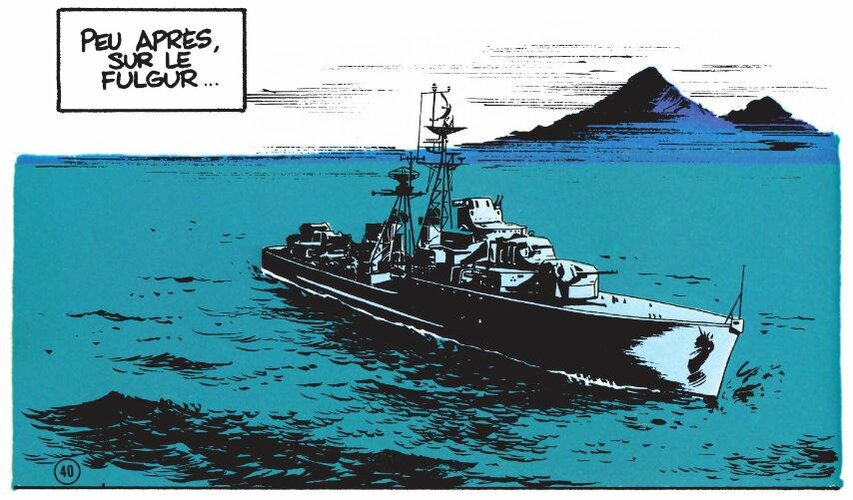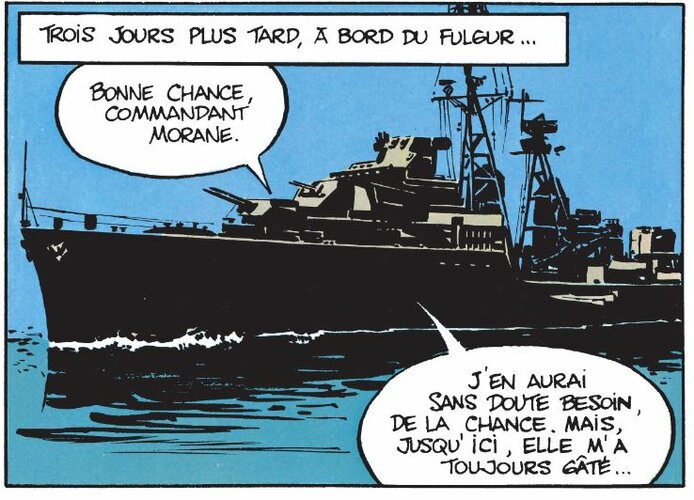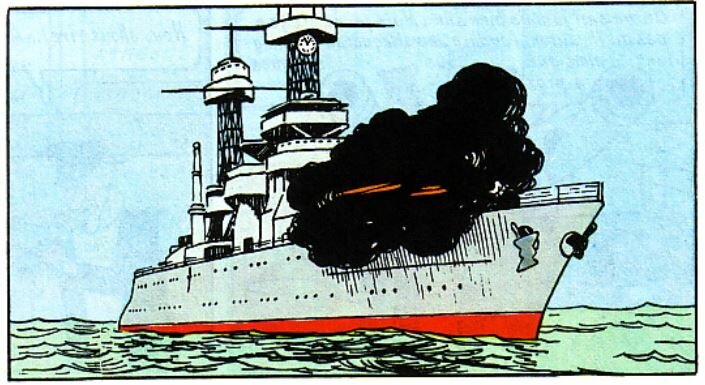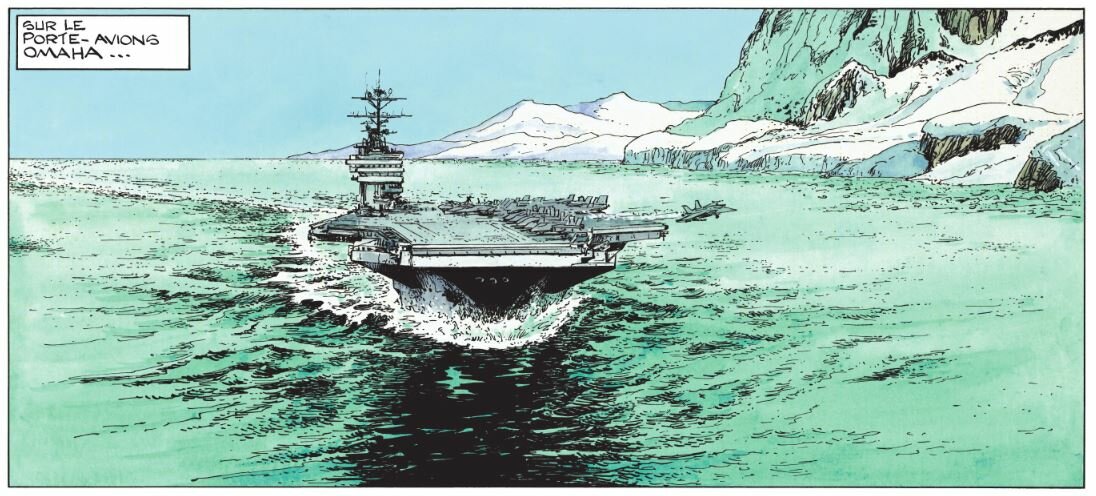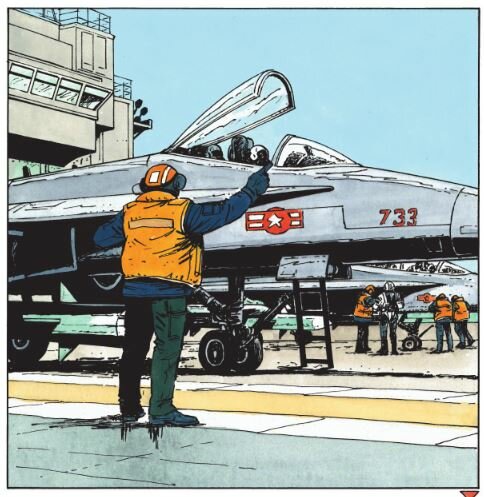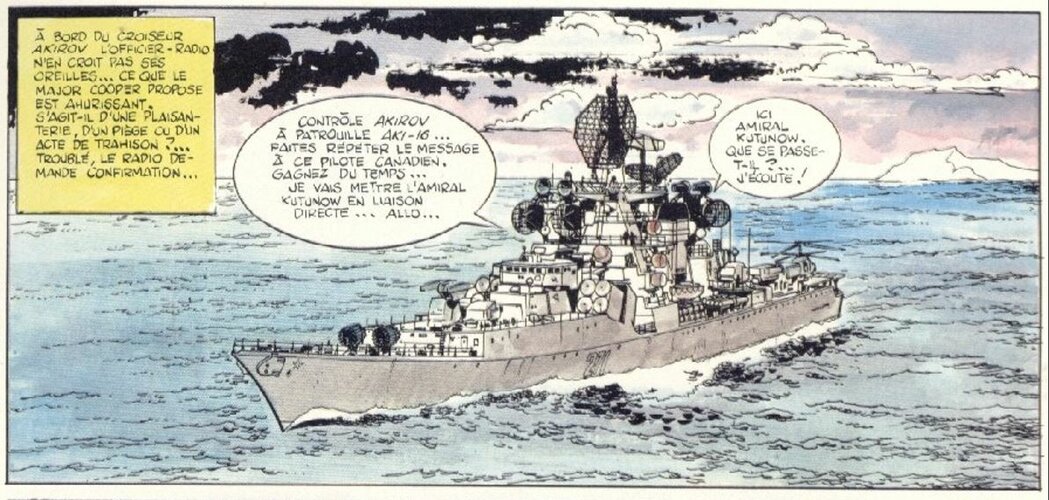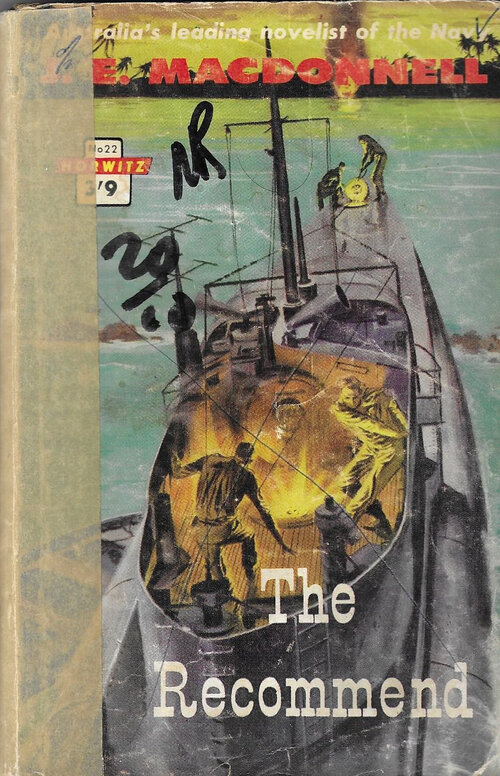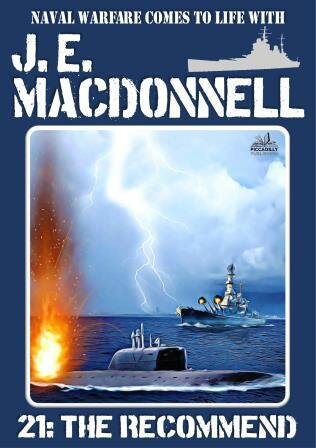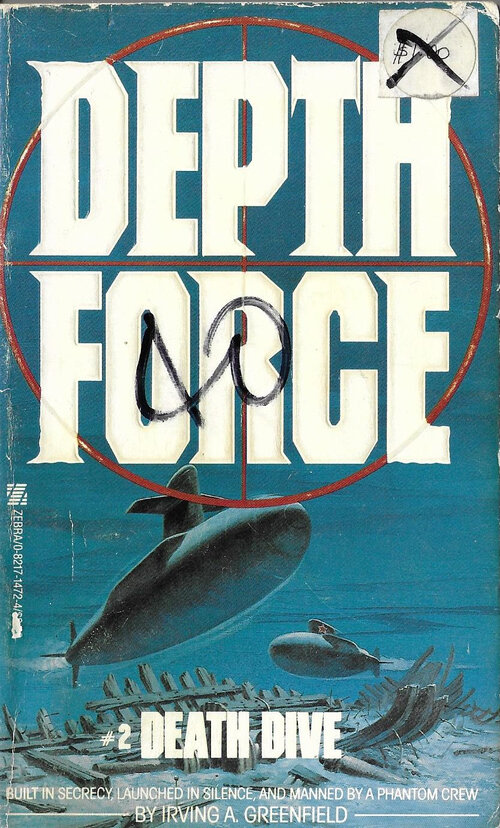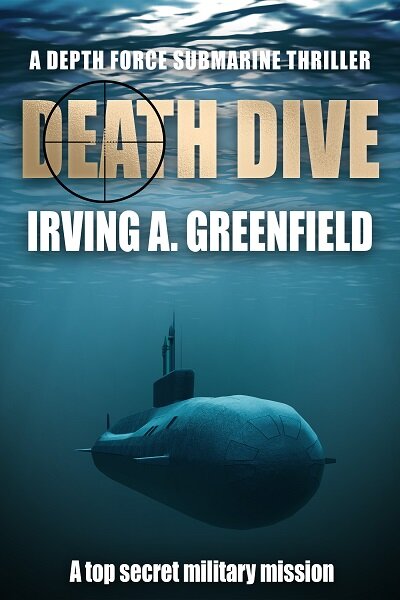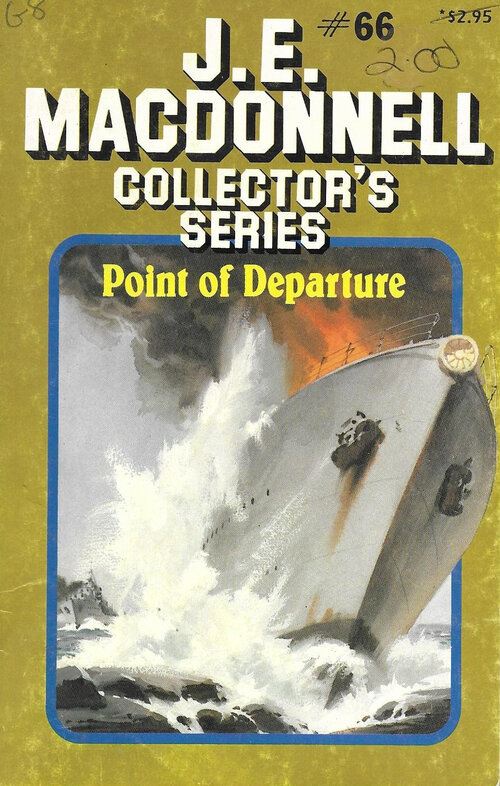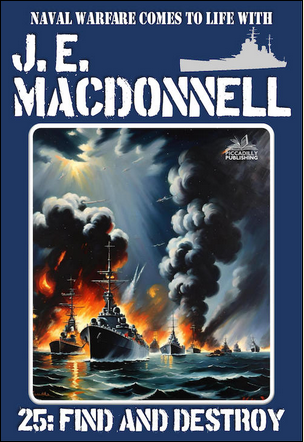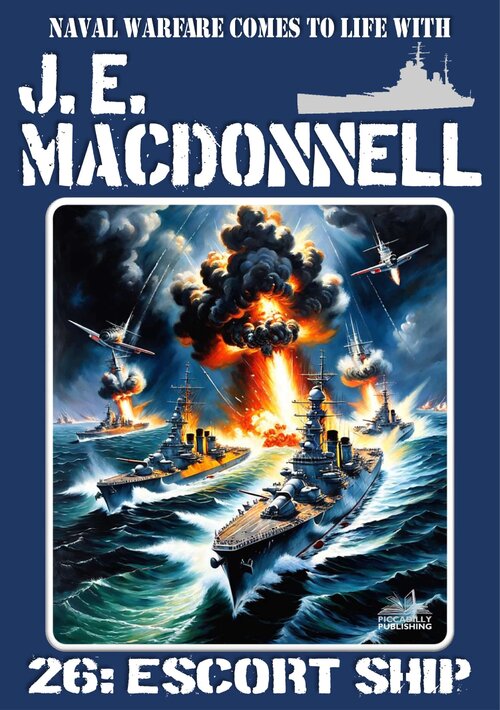You are using an out of date browser. It may not display this or other websites correctly.
You should upgrade or use an alternative browser.
You should upgrade or use an alternative browser.
Fictional Warships - Novels
F.L.
ACCESS: Top Secret
Hergé, Le Manitoba ne répond plus - "Manitoba is not responding" / 1936
Plot : An ocean liner named "Manitoba" was sailing from New York to Liverpool, when it suddenly experienced engine failure in the middle of the ocean and for some time all passengers and crew members were unconscious. When they woke up, they found that many jewellery and valuables had disappeared without a trace. Jo, Zette and Joko got involved in this adventure by accident when they were boating on the beach and they discovered that there was a hidden underwater station led by a genius professor who created many strange things.
USA
USS Eagle
New York-class battleship, used for escorting the "Washington", a civil ship.
Plot : An ocean liner named "Manitoba" was sailing from New York to Liverpool, when it suddenly experienced engine failure in the middle of the ocean and for some time all passengers and crew members were unconscious. When they woke up, they found that many jewellery and valuables had disappeared without a trace. Jo, Zette and Joko got involved in this adventure by accident when they were boating on the beach and they discovered that there was a hidden underwater station led by a genius professor who created many strange things.
USA
USS Eagle
New York-class battleship, used for escorting the "Washington", a civil ship.
Attachments
Last edited:
F.L.
ACCESS: Top Secret
Felicísimo Coria & Henri Vernes, Les Dents du Tigre - "Tiger's teeth" / 2010
Plot : Bob Morane, Bill Ballatine and Frank Reeves set off on an archaeological expedition to the Himalayas in search of the mythical city of the Lungs. There they discover that the Lungs do exist and that they are preparing to conquer Asia.
USA
USS Omaha (CVN-??)
Nimitz-class (?) aircraft carrier, with F/A-18 air group.
Plot : Bob Morane, Bill Ballatine and Frank Reeves set off on an archaeological expedition to the Himalayas in search of the mythical city of the Lungs. There they discover that the Lungs do exist and that they are preparing to conquer Asia.
USA
USS Omaha (CVN-??)
Nimitz-class (?) aircraft carrier, with F/A-18 air group.
Attachments
- Joined
- 16 December 2010
- Messages
- 3,754
- Reaction score
- 4,099
A small update, and an interesting one. In 2022 Piccadilly Publishing, an ebook publisher specializing in action/adventure novels got the rights to re-issue J. E. MacDonnell's naval fiction.
As of January 2024, 18 of the authors novels have been re-issued. I've updated two entries for J. E. MacDonnell novels ('The Surgeon' (1959) & 'Command' (1958)) to show the covers that have been created for these reprints.
As of January 2024, 18 of the authors novels have been re-issued. I've updated two entries for J. E. MacDonnell novels ('The Surgeon' (1959) & 'Command' (1958)) to show the covers that have been created for these reprints.
- Joined
- 16 December 2010
- Messages
- 3,754
- Reaction score
- 4,099
The true class identity of another J. E. MacDonnell warship has been located and can be found in the updated entries for 'The Gunner' (1959) & 'Close and Investigate' (1965)
- Joined
- 16 December 2010
- Messages
- 3,754
- Reaction score
- 4,099
Dominic Teague, Dawn of the Gorgons, published as Commando Comics Nº. 5689 (2023)
United Kingdom
HMS Wyndham
Centaur Class Aircraft Carrier
Details as per the real ships.
Note: Ship is explicitly identified as being of this class when it is introduced. It's serving as a 'Commando Carrier' for Operation Musketeer, the abortive Anglo-French invasion of Egypt in 1956. Name does not fit the class.
Plot Summary: As the RN concentrates prior to the first landings in Egypt one ship stumbles across a freighter acting oddly. The boarding party finds the cargo to be highly detailed statues some bearing expressions of shock and terror, but who, or what created them...
Note: This the sequel to October 2022's 'Night of the Gorgons' published as Commando Comics Nº. 5589 by the same author, a WWII set story that has no naval content. Certain events in this story suggest that a sequel is in the works for October 2024.
United Kingdom
HMS Wyndham
Centaur Class Aircraft Carrier
Details as per the real ships.
Note: Ship is explicitly identified as being of this class when it is introduced. It's serving as a 'Commando Carrier' for Operation Musketeer, the abortive Anglo-French invasion of Egypt in 1956. Name does not fit the class.
Plot Summary: As the RN concentrates prior to the first landings in Egypt one ship stumbles across a freighter acting oddly. The boarding party finds the cargo to be highly detailed statues some bearing expressions of shock and terror, but who, or what created them...
Note: This the sequel to October 2022's 'Night of the Gorgons' published as Commando Comics Nº. 5589 by the same author, a WWII set story that has no naval content. Certain events in this story suggest that a sequel is in the works for October 2024.
Last edited:
F.L.
ACCESS: Top Secret
Dilandu
I'm dissatisfied, which means, I exist.
Erm? It's quite well-drawn Project 1134-A "Berkut-A" class large anti-submarine ship (NATO "Kara"-class)Akirov (271)
Kirov-class (?) cruiser.
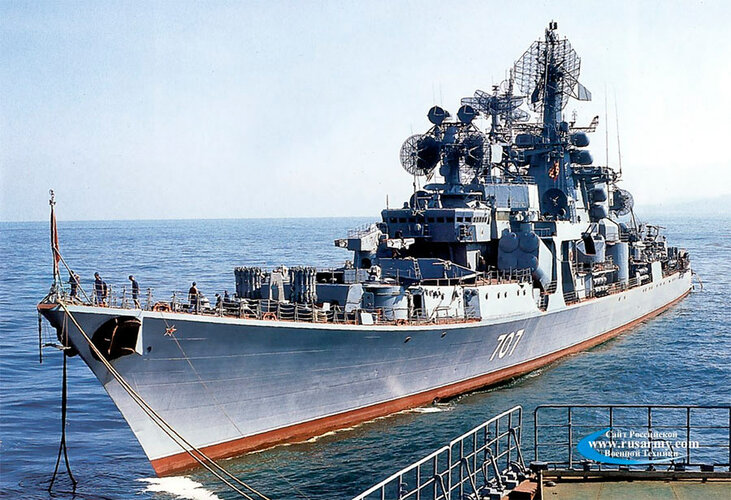
Since the 1134-A series ships were named after famous admirals, I assume it is supposed to be "Admiral Akirov" (not the most common, but perfectly possible Tatar surname)
F.L.
ACCESS: Top Secret
Dilandu
I'm dissatisfied, which means, I exist.
Thanks, @Dilandu !!!
You are welcome)
Dominic Teague, Dawn of the Gorgons, published as Commando Comics Nº. 5689 (2023)
United Kingdom
HMS Wyndham
Centaur Class Aircraft Carrier
Details as per the real ships.
Note: Ship is explicitly identified as being of this class when it is introduced. It's serving as a 'Commando Carrier' for Operation Musketeer, the abortive Anglo-French invasion of Egypt in 1956. Name does not fit the class.
Plot Summary: As the RN concentrates prior to the first landings in Egypt one ship stumbles across a freighter acting oddly. The boarding party finds the cargo to be highly detailed statues some bearing expressions of shock and terror, but who, or what created them...
Note: This the sequel to October 2022's 'Night of the Gorgons' published as Commando Comics Nº. 5589 by the same author, a WWII set story that has no naval content. Certain events in this story suggest that a sequel is in the works for October 2024.
Don't blink..........
- Joined
- 16 December 2010
- Messages
- 3,754
- Reaction score
- 4,099
Don't look, full stop...Don't blink..........
- Joined
- 16 December 2010
- Messages
- 3,754
- Reaction score
- 4,099
Nicolas Harvey, Twelve Mile Bank (AJ Bailey: 1), 2017
Germany (WWII)
U-1026
Type VIIC/41 U-Boat
Commissioned: May 1944
Sunk: May 1945
Details as per the real ships.
Note: The pennant number is that of a Type VII/C U-Boat that was launched in May 1944, but never comissioned and scuttled in an incomplete state in May 1945. In the novel the submarine is scuttled off the Cayman Islands by the crew during their third war patrol.
The author specifically states in their after story notes that they were aware of the real life submarine, probably through the website uboat.net, which I use as a source to vet U-Boat pennant numbers when I come across them in fiction.
Plot summary: A chance find while clearing out a fishing boat prior to it being offered for sale, leads a diveboat operator and her friends into a race to find a treasure lost in the dying days of the Second World War.
Note: This is the first in a series of action/adventure novels based around a diveboat operator and her friends. The backstory to the treasure is same idea used by author Patrick O'Hara as the basis of 1978 novel 'The Wohldorf Shipment' which has been covered earlier in the thread, namely that the submarine was being used to ship valuables stolen by the Nazi's to South America.
Germany (WWII)
U-1026
Type VIIC/41 U-Boat
Commissioned: May 1944
Sunk: May 1945
Details as per the real ships.
Note: The pennant number is that of a Type VII/C U-Boat that was launched in May 1944, but never comissioned and scuttled in an incomplete state in May 1945. In the novel the submarine is scuttled off the Cayman Islands by the crew during their third war patrol.
The author specifically states in their after story notes that they were aware of the real life submarine, probably through the website uboat.net, which I use as a source to vet U-Boat pennant numbers when I come across them in fiction.
Plot summary: A chance find while clearing out a fishing boat prior to it being offered for sale, leads a diveboat operator and her friends into a race to find a treasure lost in the dying days of the Second World War.
Note: This is the first in a series of action/adventure novels based around a diveboat operator and her friends. The backstory to the treasure is same idea used by author Patrick O'Hara as the basis of 1978 novel 'The Wohldorf Shipment' which has been covered earlier in the thread, namely that the submarine was being used to ship valuables stolen by the Nazi's to South America.
- Joined
- 16 December 2010
- Messages
- 3,754
- Reaction score
- 4,099
J. E. MacDonnell, The Recommend, 1960
Australia
HMAS Termagant
J, K & N Class Destroyer?
Details as per the real ships
Note: Name clash with HMS Termagant, a T Class destroyer launched in 1943, converted post war into a Type 16 Frigate and scrapped in 1965.
Japan
Various Unnamed Submarines
Plot summary: The reward for success in war, more hard work...
Notes: J. E. MacDonnell was a prolific Australian writer of action fiction for newsstand paperbacks. Some of the novels by him covered in this thread include, 'Gimme the boats!' (1953), 'The Frogman' (1958), 'Night Encounter' (1958), 'Dive,Dive,Dive!' (1959), 'The Gunner' (1959), 'The Surgeon' (1959), 'The Secret Weapon' (1959), 'Subsmash' (1960), 'Convoy' (1960), 'The Coxswain' (1960), 'The Blind Eye' (1961), 'The Ordeal' (1961), 'The Rocky' (1961), 'Away Borders!' (1962, 'Sainsbury VC' (1962), 'U-Boat' (1962), 'Not Under Command' (1963), 'Collision Course' (1964), 'Killer Group' (1964), 'Close And Investigate' (1965), 'Under Sealed Orders' (1965), 'Hell Ship' (1966), 'The Snake Boats' (1967), 'Approved to Scrap' (1968), 'Full Fathom Five' (1968), 'Judas Rat' (1968), 'The Hammer of God' (1968), 'Petty Officer Brady' (1968), 'Hunter-Killer' (1968), 'To The Death' (1969), 'The Last Stand' (1970), 'Blind Into Doom' (1972), 'The Kill', (1974), 'Standoff' (1977) 'Breaking Point' (1979), 'Command Decision' (1985), 'Jim Brady, Able Seaman' (1985) & 'The Glory Hunter' (c. 1980s) . He also wrote a series of 'James Bond' style superspy thrillers featuring an agent named Mark Hood, novels in this series that have appeared in the thread are 'Come Die With Me' (1965), 'Carribean Striker' (1967) and 'Operation Octopus' (1968).
This novel like 'Dive,Dive,Dive!' (1959) and 'Blind Into Doom' (1972) is a one-off story that features neither characters nor ships from the majority of his other naval fiction works. The two covers attached are the original Horwitz cover which depicts a scene from towards the end of the novel and the rather odd computer manipulated image Picadilly Publishing used in their Blue Cover ebook series.
Australia
HMAS Termagant
J, K & N Class Destroyer?
Details as per the real ships
Note: Name clash with HMS Termagant, a T Class destroyer launched in 1943, converted post war into a Type 16 Frigate and scrapped in 1965.
Japan
Various Unnamed Submarines
Plot summary: The reward for success in war, more hard work...
Notes: J. E. MacDonnell was a prolific Australian writer of action fiction for newsstand paperbacks. Some of the novels by him covered in this thread include, 'Gimme the boats!' (1953), 'The Frogman' (1958), 'Night Encounter' (1958), 'Dive,Dive,Dive!' (1959), 'The Gunner' (1959), 'The Surgeon' (1959), 'The Secret Weapon' (1959), 'Subsmash' (1960), 'Convoy' (1960), 'The Coxswain' (1960), 'The Blind Eye' (1961), 'The Ordeal' (1961), 'The Rocky' (1961), 'Away Borders!' (1962, 'Sainsbury VC' (1962), 'U-Boat' (1962), 'Not Under Command' (1963), 'Collision Course' (1964), 'Killer Group' (1964), 'Close And Investigate' (1965), 'Under Sealed Orders' (1965), 'Hell Ship' (1966), 'The Snake Boats' (1967), 'Approved to Scrap' (1968), 'Full Fathom Five' (1968), 'Judas Rat' (1968), 'The Hammer of God' (1968), 'Petty Officer Brady' (1968), 'Hunter-Killer' (1968), 'To The Death' (1969), 'The Last Stand' (1970), 'Blind Into Doom' (1972), 'The Kill', (1974), 'Standoff' (1977) 'Breaking Point' (1979), 'Command Decision' (1985), 'Jim Brady, Able Seaman' (1985) & 'The Glory Hunter' (c. 1980s) . He also wrote a series of 'James Bond' style superspy thrillers featuring an agent named Mark Hood, novels in this series that have appeared in the thread are 'Come Die With Me' (1965), 'Carribean Striker' (1967) and 'Operation Octopus' (1968).
This novel like 'Dive,Dive,Dive!' (1959) and 'Blind Into Doom' (1972) is a one-off story that features neither characters nor ships from the majority of his other naval fiction works. The two covers attached are the original Horwitz cover which depicts a scene from towards the end of the novel and the rather odd computer manipulated image Picadilly Publishing used in their Blue Cover ebook series.
Attachments
Last edited:
- Joined
- 16 December 2010
- Messages
- 3,754
- Reaction score
- 4,099
Clegg (Pseud.), Sea Snatch, first published in Commando Comics Nº. 502 (1970), republished as Commando Comics Nº.5696 (2023)
Germany
Brunkel
U-Boat Supply Ship
Armament (Based on the illustration): 8 x 37mm guns in four twin mounts.
The illustration suggests the ship is a converted merchant vessel.
Unnamed S-Boats
United Kingdom
Unnamed MTBs
Plot summary: For two Norwegian pilots in the RAF, the decision to help out the Norwegian Resistance was an easy one, they just should have run it past their C.O. first...
Germany
Brunkel
U-Boat Supply Ship
Armament (Based on the illustration): 8 x 37mm guns in four twin mounts.
The illustration suggests the ship is a converted merchant vessel.
Unnamed S-Boats
United Kingdom
Unnamed MTBs
Plot summary: For two Norwegian pilots in the RAF, the decision to help out the Norwegian Resistance was an easy one, they just should have run it past their C.O. first...
Last edited:
- Joined
- 16 December 2010
- Messages
- 3,754
- Reaction score
- 4,099
Durand Keifer, Destroyer For England, published in Adventure Magazine, June 1941
United Kingdom
HMS Huntington (ex-USS Wingate)
Town Class Destroyer
Details as per one of the three classes (Clemson, Wickes, Caldwell) of US destroyer that were transferred in the 1940 'Bases for Destroyers' deal. The story does not provide sufficient detail to pin down which class the ship was.
Plot summary: A recently discharged member of the US Navy joins the Royal Navy to see his old ship across the Atlantic in the days before the attack on Pearl Harbor.
United Kingdom
HMS Huntington (ex-USS Wingate)
Town Class Destroyer
Details as per one of the three classes (Clemson, Wickes, Caldwell) of US destroyer that were transferred in the 1940 'Bases for Destroyers' deal. The story does not provide sufficient detail to pin down which class the ship was.
Plot summary: A recently discharged member of the US Navy joins the Royal Navy to see his old ship across the Atlantic in the days before the attack on Pearl Harbor.
TheRejectionist
ACCESS: Secret
- Joined
- 2 February 2022
- Messages
- 237
- Reaction score
- 64
- Joined
- 16 December 2010
- Messages
- 3,754
- Reaction score
- 4,099
John-Allen Price, Extinction Cruise, 1987
Russia (Soviet Union)
Giena
Primor'ye (Pr.394B) Class Spy Ship
Details as per the real ships
Baykal
Primor'ye (Pr.394B) Class Spy Ship
Details as per the real ships
'Queens Pawn Twelve' (Real name - ?)
Delta Class Submarine (Subclass not specified)
Details as per the real ships
Note: The author never gives the submarine an actual name despite scenes aboard her involving her crew, or during later scenes involving Soviet naval officers discussing the submarine. At one point in the novel he reveals a code identity 'Queens Pawn Twelve' and this is used alternating with 'submarine' or 'the submarine' throughout the novel subsequently.
Kronstadt
Oscar (Pr. 949) SSGN, subclass not specified
No other details provided
Sergei Chirikov
Victor III (Pr. 671RTM/RTMK) Class Submarine
Details as per the real ships.
Note: Possibly real, I cannot find a good source for Victor Class names.
Bugayev
Victor III (Pr. 671RTM/RTMK) Class Submarine
Details as per the real ships.
Note: Possibly real, I cannot find a good source for Victor Class names.
Komsomolec
Kiev (Pr. 1143) Class Aircraft Carrier
Details as per the real ships.
Maxim Gorky
CVN, class not specified
Note: Type assignment based on the line that immediately follows the mention of the ships name, "When we last met you boasted as much to me. Or, have you been promised a command on our next nuclear-powered aircraft carrier?"
Mikhail Kalinin
Oiler, class not specified.
No other details provided
Vladimir Davidov
Oiler, class not specified
Note: Described as a 'half-sister' to the Mikhail Kalinin.
All other ships mentioned in the novel are real.
Norway
HNoMS Stavanger (F303)
Oslo Class Frigate
Real ship, details as in service 1966 - 1988
United Kingdom
HMS Illustrious (R06)
Invincible Class Aircraft Carrier.
Real ship, details as in service 1982 - 2014
RFA Reliant (A131)
Helicopter Support Ship
Real ship, details as in service 1983 - 1986
All other ships mentioned in the novel are real.
United States
USS Henry Clay (SSBN-625)
Real ship, details as in service 1964 - 1990
In the novel the ship is fitted with a system named 'Sub-Scape' that releases friction reducing polymers from nozzles around the submarines hull, this permits a temporary doubling of the submarines underwater speed.
USS Buffalo (SSN-715)
Real ship, details as in service 1983 - 2017
In the novel the ship is fitted with a system named 'Sub-Scape' that releases friction reducing polymers from nozzles around the submarines hull, this permits a temporary doubling of the submarines underwater speed.
All other ships mentioned are real. The implication in the novel is that all US nuclear submarines are fitted with 'Sub-Scape' but this is not explicitly stated by the author.
Plot summary. The year is 1989 (The novel takes place between June 22nd and July 6th of this year.) at a time of high international tension, the crew of a Soviet SSBN decide to defect to the West, setting off a crisis that brings the world to the brink of WWIII.
Note: The novel, aside from borrowing heavily from the iconic 'The Hunt For Red October' (1984) by Tom Clancy, is another work that exhibits a 'future of the past' quality, as real world events rapidly made the authors plotline obsolete.
Other novels exhibiting this 'future of the past' quality I've covered are 'Seven Days in May' (1962) (Charles W. Bailey II & Fletcher Knebel), 'Thirty-Four East' (1974), 'The Hastings Conspiracy' (1980) (Both by Alfred Coppel), 'The Crash of '79' (1976) (Paul E. Erdman), 'North Star Crusade' (1976) (William Katz), 'Side-Wall' (1982) (David Graham), 'CV' (1985) (Damon Knight), 'The Phoenix Odyssey' (1986) (Richard P. Henrick), 'Rockets' Red Glare' (1988) (Greg Dinallo), 'Super Depth Force: Project Discovery' (1988) (Irving A. Greenfield), 'Omega Sub' (1991) (Michael Jahn) 'Debt of Honor' (1994) (Tom Clancy) 'Rites of War' (1998) (Cyn Mobley) and 'End Game' (2011) (Matthew Glass), along with what is probably the most well known 'alternative history' sequence, 'Raise the Titanic' (1976), 'Vixen 03' (1978), 'Night Probe' (1981) & 'Deep Six' (1984) (All by Clive Cussler) which are set in an alternative 1980s (The novels are set between 1987 ('Raise the Titanic') & 1989 ('Deep Six').) with many differences from what actually happened, most notably Canada being absorbed by the United States (Something Cussler quietly dropped in later novels.). Other noteable 'Future of the Past' series I've covered are the four book 'Amanda Garrett' series ('Choosers of the Slain' (1996), 'Stormdragon' (1997), 'Seafighter' (1999) & 'Target Lock' (2002)) by James H. Cobb and the 'America's Cup Trilogy' ('Challenge' (1990), 'New World' (1991) & 'Death Of An Angel' (1992)) by Warwick Collins.
Russia (Soviet Union)
Giena
Primor'ye (Pr.394B) Class Spy Ship
Details as per the real ships
Baykal
Primor'ye (Pr.394B) Class Spy Ship
Details as per the real ships
'Queens Pawn Twelve' (Real name - ?)
Delta Class Submarine (Subclass not specified)
Details as per the real ships
Note: The author never gives the submarine an actual name despite scenes aboard her involving her crew, or during later scenes involving Soviet naval officers discussing the submarine. At one point in the novel he reveals a code identity 'Queens Pawn Twelve' and this is used alternating with 'submarine' or 'the submarine' throughout the novel subsequently.
Kronstadt
Oscar (Pr. 949) SSGN, subclass not specified
No other details provided
Sergei Chirikov
Victor III (Pr. 671RTM/RTMK) Class Submarine
Details as per the real ships.
Note: Possibly real, I cannot find a good source for Victor Class names.
Bugayev
Victor III (Pr. 671RTM/RTMK) Class Submarine
Details as per the real ships.
Note: Possibly real, I cannot find a good source for Victor Class names.
Komsomolec
Kiev (Pr. 1143) Class Aircraft Carrier
Details as per the real ships.
Maxim Gorky
CVN, class not specified
Note: Type assignment based on the line that immediately follows the mention of the ships name, "When we last met you boasted as much to me. Or, have you been promised a command on our next nuclear-powered aircraft carrier?"
Mikhail Kalinin
Oiler, class not specified.
No other details provided
Vladimir Davidov
Oiler, class not specified
Note: Described as a 'half-sister' to the Mikhail Kalinin.
All other ships mentioned in the novel are real.
Norway
HNoMS Stavanger (F303)
Oslo Class Frigate
Real ship, details as in service 1966 - 1988
United Kingdom
HMS Illustrious (R06)
Invincible Class Aircraft Carrier.
Real ship, details as in service 1982 - 2014
RFA Reliant (A131)
Helicopter Support Ship
Real ship, details as in service 1983 - 1986
All other ships mentioned in the novel are real.
United States
USS Henry Clay (SSBN-625)
Real ship, details as in service 1964 - 1990
In the novel the ship is fitted with a system named 'Sub-Scape' that releases friction reducing polymers from nozzles around the submarines hull, this permits a temporary doubling of the submarines underwater speed.
USS Buffalo (SSN-715)
Real ship, details as in service 1983 - 2017
In the novel the ship is fitted with a system named 'Sub-Scape' that releases friction reducing polymers from nozzles around the submarines hull, this permits a temporary doubling of the submarines underwater speed.
All other ships mentioned are real. The implication in the novel is that all US nuclear submarines are fitted with 'Sub-Scape' but this is not explicitly stated by the author.
Plot summary. The year is 1989 (The novel takes place between June 22nd and July 6th of this year.) at a time of high international tension, the crew of a Soviet SSBN decide to defect to the West, setting off a crisis that brings the world to the brink of WWIII.
Note: The novel, aside from borrowing heavily from the iconic 'The Hunt For Red October' (1984) by Tom Clancy, is another work that exhibits a 'future of the past' quality, as real world events rapidly made the authors plotline obsolete.
Other novels exhibiting this 'future of the past' quality I've covered are 'Seven Days in May' (1962) (Charles W. Bailey II & Fletcher Knebel), 'Thirty-Four East' (1974), 'The Hastings Conspiracy' (1980) (Both by Alfred Coppel), 'The Crash of '79' (1976) (Paul E. Erdman), 'North Star Crusade' (1976) (William Katz), 'Side-Wall' (1982) (David Graham), 'CV' (1985) (Damon Knight), 'The Phoenix Odyssey' (1986) (Richard P. Henrick), 'Rockets' Red Glare' (1988) (Greg Dinallo), 'Super Depth Force: Project Discovery' (1988) (Irving A. Greenfield), 'Omega Sub' (1991) (Michael Jahn) 'Debt of Honor' (1994) (Tom Clancy) 'Rites of War' (1998) (Cyn Mobley) and 'End Game' (2011) (Matthew Glass), along with what is probably the most well known 'alternative history' sequence, 'Raise the Titanic' (1976), 'Vixen 03' (1978), 'Night Probe' (1981) & 'Deep Six' (1984) (All by Clive Cussler) which are set in an alternative 1980s (The novels are set between 1987 ('Raise the Titanic') & 1989 ('Deep Six').) with many differences from what actually happened, most notably Canada being absorbed by the United States (Something Cussler quietly dropped in later novels.). Other noteable 'Future of the Past' series I've covered are the four book 'Amanda Garrett' series ('Choosers of the Slain' (1996), 'Stormdragon' (1997), 'Seafighter' (1999) & 'Target Lock' (2002)) by James H. Cobb and the 'America's Cup Trilogy' ('Challenge' (1990), 'New World' (1991) & 'Death Of An Angel' (1992)) by Warwick Collins.
Last edited:
Scott Kenny
ACCESS: USAP
- Joined
- 15 May 2023
- Messages
- 11,258
- Reaction score
- 13,695
That was certainly one of the ideas that the USN was kicking around in the 1980s... I think it was even tested at some scale, but not on a ship.USS Buffalo (SSN-715)
Real ship, details as in service 1983 - 2017
In the novel the ship is fitted with a system named 'Sub-Scape' that releases friction reducing polymers from nozzles around the submarines hull, this permits a temporary doubling of the submarines underwater speed.
All other ships referenced mentioned are real. The implication in the novel is that all US nuclear submarines are fitted with 'Sub-Scape' but this is not explicitly stated by the author.
- Joined
- 16 December 2010
- Messages
- 3,754
- Reaction score
- 4,099
Thanks for the additional information.That was certainly one of the ideas that the USN was kicking around in the 1980s... I think it was even tested at some scale, but not on a ship.
- Joined
- 16 December 2010
- Messages
- 3,754
- Reaction score
- 4,099
J. E. MacDonnell, Mission Hopeless, 1968
Australia
HMAS Wind Rode (G46)
Tribal Class Destroyer
Details as per the real ships
Note: The name does not fit the class. Also appears in several other of the authors many novels. In other entries in this thread I had identified this as a J, K & N Class Destroyer, which is my version of the non-descript term 'Fleet Destroyer' used by the author. This only applies for those entries where the author does not identify the ship as a V & W Class Destroyer. The ships true class identity is revealed in the closing pages of the 1959 novel 'The Gunner'.
HMAS Circe
'Destroyer', class not specified.
No class specifics are provided.
Note: Most likely a 'J, K & N Class Destroyer' or what the author termed a 'Fleet Destroyer'. The name clashes both with a minesweeper that entered service in 1939 and transferred to Australia as HMAS Medea in 1942 and with a minesweeper launched in 1942 and scrapped in 1967.
HMAS Jackal (ex-HMAS Fane, ex-HMS Jutland)
Battle Class Destroyer (1943)
Details as per the real ships
Note: The name clashes with that of a J Class destroyer named HMS Jackal that was sunk in May of 1942. The name also appears in the authors fiction in the form of an R Class (WWII) Destroyer that is captained by the character 'Dutchy' Holland until some time after November 6, 1944 when it is scrapped due to battle damage. The Battle Class Destroyer was gifted to Australia by the British as a stop-gap until "...our Tribals come into commission." There were three Tribal Class Destroyers built in Australia, the first two HMAS Arunta & HMAS Warramunga entered service in 1942. The last one HMAS Bataan (ex-HMAS Kurnai) did not enter service until 1945.
There were actually two Battle Class Destroyers named HMS Jutland, the first was scrapped incomplete in 1957, the second started construction as HMS Malplaquet but was renamed prior to launch in 1946.
In the novel 'Approved to Scrap' (1968), Holland is assigned the ship under the name HMAS Fane, in this novel it is revealed that he successfully applied pressure on the RAN Naming Commission to have the ship renamed HMAS Jackal shortly after taking command.
Japan
I-128
Submarine (Minelayer), class not specified.
No other details provided.
Note: The author has the characters consult a fictional edition of 'Janes Fighting Ships' for details on the submarine. I suspect that the author used real editions of Janes when he was writing. The only IJN minelaying submarines were the Type I-121 Class built in the 1920s. They were I-21, I-22, I-23 and I-24 which in 1938 were renumbered I-121, I-122, I-123 and I-124. There were no other submarines in the I-12x series. The dialog in the novel implies that the presumed I-125 to I-128 were an improved version of the earlier class, though no specifics are provided as to what these changes were.
Other Unnamed warships.
Plot summary: Skill can carry you only so far in war, sometimes luck is needed and sometimes luck can run out...
Note: This is an unusual novel in the authors output, before the story the reader is treated to a foreward relaying an old anecdote in which a scriptwriter for a long running radio drama asks for a payrise, is refused and retaliates by writing the series hero into an impossible position and then tendering his resignation. Since no-one else can figure out how to continue the story, the screenwriter is lured back with higher pay.
It's a tale that has similarities to one told by author John D. MacDonald about how he had created a 20 or so page manuscript in which his popular series hero 'Travis McGee' was killed off as a bargaining chip to show to publishers when discussing royalty payments. This story led to rumors that the author had written a full novel in which the hero is killed off to be published after the authors death, rumors which were proven false in the event.
As to the version given in the stories foreward, this is more or less what happens at the end of the tale. One of his series characters find's themselves facing off alone against a major Japanese taskforce and escapes in a manner that can only be described as unlikely. Did the author have his own confontation with his publishers over payment? It's a secret the author took to his grave.
Australia
HMAS Wind Rode (G46)
Tribal Class Destroyer
Details as per the real ships
Note: The name does not fit the class. Also appears in several other of the authors many novels. In other entries in this thread I had identified this as a J, K & N Class Destroyer, which is my version of the non-descript term 'Fleet Destroyer' used by the author. This only applies for those entries where the author does not identify the ship as a V & W Class Destroyer. The ships true class identity is revealed in the closing pages of the 1959 novel 'The Gunner'.
HMAS Circe
'Destroyer', class not specified.
No class specifics are provided.
Note: Most likely a 'J, K & N Class Destroyer' or what the author termed a 'Fleet Destroyer'. The name clashes both with a minesweeper that entered service in 1939 and transferred to Australia as HMAS Medea in 1942 and with a minesweeper launched in 1942 and scrapped in 1967.
HMAS Jackal (ex-HMAS Fane, ex-HMS Jutland)
Battle Class Destroyer (1943)
Details as per the real ships
Note: The name clashes with that of a J Class destroyer named HMS Jackal that was sunk in May of 1942. The name also appears in the authors fiction in the form of an R Class (WWII) Destroyer that is captained by the character 'Dutchy' Holland until some time after November 6, 1944 when it is scrapped due to battle damage. The Battle Class Destroyer was gifted to Australia by the British as a stop-gap until "...our Tribals come into commission." There were three Tribal Class Destroyers built in Australia, the first two HMAS Arunta & HMAS Warramunga entered service in 1942. The last one HMAS Bataan (ex-HMAS Kurnai) did not enter service until 1945.
There were actually two Battle Class Destroyers named HMS Jutland, the first was scrapped incomplete in 1957, the second started construction as HMS Malplaquet but was renamed prior to launch in 1946.
In the novel 'Approved to Scrap' (1968), Holland is assigned the ship under the name HMAS Fane, in this novel it is revealed that he successfully applied pressure on the RAN Naming Commission to have the ship renamed HMAS Jackal shortly after taking command.
Japan
I-128
Submarine (Minelayer), class not specified.
No other details provided.
Note: The author has the characters consult a fictional edition of 'Janes Fighting Ships' for details on the submarine. I suspect that the author used real editions of Janes when he was writing. The only IJN minelaying submarines were the Type I-121 Class built in the 1920s. They were I-21, I-22, I-23 and I-24 which in 1938 were renumbered I-121, I-122, I-123 and I-124. There were no other submarines in the I-12x series. The dialog in the novel implies that the presumed I-125 to I-128 were an improved version of the earlier class, though no specifics are provided as to what these changes were.
Other Unnamed warships.
Plot summary: Skill can carry you only so far in war, sometimes luck is needed and sometimes luck can run out...
Note: This is an unusual novel in the authors output, before the story the reader is treated to a foreward relaying an old anecdote in which a scriptwriter for a long running radio drama asks for a payrise, is refused and retaliates by writing the series hero into an impossible position and then tendering his resignation. Since no-one else can figure out how to continue the story, the screenwriter is lured back with higher pay.
It's a tale that has similarities to one told by author John D. MacDonald about how he had created a 20 or so page manuscript in which his popular series hero 'Travis McGee' was killed off as a bargaining chip to show to publishers when discussing royalty payments. This story led to rumors that the author had written a full novel in which the hero is killed off to be published after the authors death, rumors which were proven false in the event.
As to the version given in the stories foreward, this is more or less what happens at the end of the tale. One of his series characters find's themselves facing off alone against a major Japanese taskforce and escapes in a manner that can only be described as unlikely. Did the author have his own confontation with his publishers over payment? It's a secret the author took to his grave.
Last edited:
- Joined
- 16 December 2010
- Messages
- 3,754
- Reaction score
- 4,099
Irving A. Greenfield, Death Dive (Depth Force: 2), 1984
United States
USS Shark
Submarine, class not specified
Displacement: 25,000 tons
Length: 352ft (107.3m)
Beam: 45ft (13.7m)
Rated Maximum Operating depth: 3000ft
Engines: Nuclear (Uses High, rather than low pressure steam)
Speed: 60knots (Max, not specified if submerged or surfaced speed.)
Crew: 40
Armament: Unspecified Surface to Air & Surface to Surface Missiles, 4 x ICBMs with MIRV warheads (Most likely Tridents), 8 x TT (4 bow and 4 stern), 2 x 6 inch guns, 2 x 20mm guns mounted in the sail.
Electronics: The submarine is highly automated allowing many standard crew positions to be eliminated. The computer provides three dimensional projections of the submarines surrounds through two systems. The Grid Display Table (GDT) provides a precise map of the submarines surroundings and also allows a sonar 'snapshot' of everything within a 5000yard (4.6km) sphere of the submarine to be taken. The UnderWater Image Screen (UWIS) is a visual imager that displays a synthetic image of the submarines exterior based on the input from the submarines sensors. Also fitted is an Aircraft Target Indicator (ATI) capable of tracking 50 airborne targets simultaneously and determining their threat priority.
Hull: Three layer construction, outer layer is steel, middle layer is a glass like form of silicone and the inner layer is aluminum.
Also carries two "...undersea recon craft...". These are described as "...delta wing shaped and driven by an electric motor... fifteen knots under water and four at the surface. They were equipped with sufficient air supply... two men for six hours and they were armed with four mini torpedoes, each of which had an effective operating range of four thousand yards."
Note: Conning tower is retracted into the hull underwater to allow for the high speed. The submarine is not attached to the United States Navy but is operating under the auspices of the CIA.
MV Tecumseh
Submarine Support Ship (Modified Oil Tanker)
No specifics as to dimensions, but large enough to house a dock for the USS Shark inside the hull.
Engines: Nuclear (Stated to be identical to the power plant used on the Nimitz Class Aircraft Carriers, the ship has been designed to simulate use of a conventional power plant.)
Note: Nominally owned by the Thomas W. Williams Company (Stated to be a shell company owned by the CIA.), the crew of the USS Shark are listed as crew members, but there is also a cover crew on board. During the briefing it's stated the idea for this ship was taken from an "...old James Bond film." This is the film 'From Russia with Love', whose novelization I've covered earlier in the thread.
USS George Washington
'Aircraft Carrier', class not specified. Possibly the Nimitz Class Carrier of the same name, see the notes below.
No other details provided
Note: At the time the novel came out the name would have clashed with the lead ship of the George Washington Class SSBNs, the next ship to bear the name was the Nimitz Class Aircraft Carrier USS George Washington (CVN-73) which entered service in 1992 having been ordered in 1982. It is possible the author meant this to be the Nimitz Class ship, but no class specifics are mentioned.
USS Stanley
'Destroyer', class not specified
No other details provided
Note: Author calls the ship an 'escort destroyer'
USS Harris
'Destroyer', class not specified
No other details provided
Note: Author calls the ship an 'escort destroyer'
USS Seward
'Destroyer', class not specified
No other details provided
Note: Author calls the ship an 'escort destroyer'
USS Barley
'Destroyer', class not specified
No other details provided
Note: Author calls the ship an 'escort destroyer'
USS Paul
'Frigate', class not specified
No other details provided
Note: Author calls the ship an 'guided missile frigate'
USS Victor
'Frigate', class not specified
No other details provided
Note: Author calls the ship an 'guided missile frigate'
Russia
Q-21
Submarine (SSN), class not specified
Speed: 40 knots (Submerged)
Crew: 42
Armament: 5 x IRBMs (Three fwd of conning tower, two aft), 1 x 130mm gun (FWD), 2 x ZSU-23 AA guns (One on conning tower, one aft of conning tower), 6 x TT (4 bow, 2 stern)
Can handle all types of torpedos currently in service with the Russian navy, also carries torpedoes that are sonar (5km range)/television (500m) guided.
Captain has unofficialy named the ship "...More Dekar'..." which the author translates as 'Sea Savage', according to Google Translate the correct Russian would be "...Morskoy Dikar'..."
No other details provided.
Plot summary: Following their harrowing mission to destroy a Soviet missile base in the South Pacific, the crew of the USS Shark are given a break before being pitched into an operation designed to stop the Russians from salvaging gold from shipwrecks off the Skeleton Coast of Africa.
Note: This is the second in a series that ran between 1984 and 1992, sporting impressive covers that should have been used for the fiction of Richard P. Henrick, the plots by veteran author Irving A. Greenfield are more focussed on intercharacter relationships than straight up action.
The basic structure for each novel was, first resolve the ending of the previous novel. Then follow with a 'soap opera' interlude with lots of sex that takes up much of the book. From this interlude emerge plot threads that build to an action climax that ends in a cliffhanger. It's been speculated that the reason for the series relative success was the decision to end each story on a cliffhanger that was resolved at the start of the next novel in the series.
The two covers are, the original Zebra cover, taken from a rather battered edition I found in the 'cheap books' pile outside a second hand bookshop and the other comes from a recent eBook re-issue by UK Based eBook publisher Sapere Books who I think would have been better served had they obtained the rights to republish Richard P. Henrick's fiction.
Other novels by Irving A. Greenfield, I've covered in the thread are 'Barracuda' (1978), 'Depth Force' (1984), 'Torpedo Tomb (Depth Force: 5)' (1986) and 'Super Depth Force: Project Discovery' (1988).
United States
USS Shark
Submarine, class not specified
Displacement: 25,000 tons
Length: 352ft (107.3m)
Beam: 45ft (13.7m)
Rated Maximum Operating depth: 3000ft
Engines: Nuclear (Uses High, rather than low pressure steam)
Speed: 60knots (Max, not specified if submerged or surfaced speed.)
Crew: 40
Armament: Unspecified Surface to Air & Surface to Surface Missiles, 4 x ICBMs with MIRV warheads (Most likely Tridents), 8 x TT (4 bow and 4 stern), 2 x 6 inch guns, 2 x 20mm guns mounted in the sail.
Electronics: The submarine is highly automated allowing many standard crew positions to be eliminated. The computer provides three dimensional projections of the submarines surrounds through two systems. The Grid Display Table (GDT) provides a precise map of the submarines surroundings and also allows a sonar 'snapshot' of everything within a 5000yard (4.6km) sphere of the submarine to be taken. The UnderWater Image Screen (UWIS) is a visual imager that displays a synthetic image of the submarines exterior based on the input from the submarines sensors. Also fitted is an Aircraft Target Indicator (ATI) capable of tracking 50 airborne targets simultaneously and determining their threat priority.
Hull: Three layer construction, outer layer is steel, middle layer is a glass like form of silicone and the inner layer is aluminum.
Also carries two "...undersea recon craft...". These are described as "...delta wing shaped and driven by an electric motor... fifteen knots under water and four at the surface. They were equipped with sufficient air supply... two men for six hours and they were armed with four mini torpedoes, each of which had an effective operating range of four thousand yards."
Note: Conning tower is retracted into the hull underwater to allow for the high speed. The submarine is not attached to the United States Navy but is operating under the auspices of the CIA.
MV Tecumseh
Submarine Support Ship (Modified Oil Tanker)
No specifics as to dimensions, but large enough to house a dock for the USS Shark inside the hull.
Engines: Nuclear (Stated to be identical to the power plant used on the Nimitz Class Aircraft Carriers, the ship has been designed to simulate use of a conventional power plant.)
Note: Nominally owned by the Thomas W. Williams Company (Stated to be a shell company owned by the CIA.), the crew of the USS Shark are listed as crew members, but there is also a cover crew on board. During the briefing it's stated the idea for this ship was taken from an "...old James Bond film." This is the film 'From Russia with Love', whose novelization I've covered earlier in the thread.
USS George Washington
'Aircraft Carrier', class not specified. Possibly the Nimitz Class Carrier of the same name, see the notes below.
No other details provided
Note: At the time the novel came out the name would have clashed with the lead ship of the George Washington Class SSBNs, the next ship to bear the name was the Nimitz Class Aircraft Carrier USS George Washington (CVN-73) which entered service in 1992 having been ordered in 1982. It is possible the author meant this to be the Nimitz Class ship, but no class specifics are mentioned.
USS Stanley
'Destroyer', class not specified
No other details provided
Note: Author calls the ship an 'escort destroyer'
USS Harris
'Destroyer', class not specified
No other details provided
Note: Author calls the ship an 'escort destroyer'
USS Seward
'Destroyer', class not specified
No other details provided
Note: Author calls the ship an 'escort destroyer'
USS Barley
'Destroyer', class not specified
No other details provided
Note: Author calls the ship an 'escort destroyer'
USS Paul
'Frigate', class not specified
No other details provided
Note: Author calls the ship an 'guided missile frigate'
USS Victor
'Frigate', class not specified
No other details provided
Note: Author calls the ship an 'guided missile frigate'
Russia
Q-21
Submarine (SSN), class not specified
Speed: 40 knots (Submerged)
Crew: 42
Armament: 5 x IRBMs (Three fwd of conning tower, two aft), 1 x 130mm gun (FWD), 2 x ZSU-23 AA guns (One on conning tower, one aft of conning tower), 6 x TT (4 bow, 2 stern)
Can handle all types of torpedos currently in service with the Russian navy, also carries torpedoes that are sonar (5km range)/television (500m) guided.
Captain has unofficialy named the ship "...More Dekar'..." which the author translates as 'Sea Savage', according to Google Translate the correct Russian would be "...Morskoy Dikar'..."
No other details provided.
Plot summary: Following their harrowing mission to destroy a Soviet missile base in the South Pacific, the crew of the USS Shark are given a break before being pitched into an operation designed to stop the Russians from salvaging gold from shipwrecks off the Skeleton Coast of Africa.
Note: This is the second in a series that ran between 1984 and 1992, sporting impressive covers that should have been used for the fiction of Richard P. Henrick, the plots by veteran author Irving A. Greenfield are more focussed on intercharacter relationships than straight up action.
The basic structure for each novel was, first resolve the ending of the previous novel. Then follow with a 'soap opera' interlude with lots of sex that takes up much of the book. From this interlude emerge plot threads that build to an action climax that ends in a cliffhanger. It's been speculated that the reason for the series relative success was the decision to end each story on a cliffhanger that was resolved at the start of the next novel in the series.
The two covers are, the original Zebra cover, taken from a rather battered edition I found in the 'cheap books' pile outside a second hand bookshop and the other comes from a recent eBook re-issue by UK Based eBook publisher Sapere Books who I think would have been better served had they obtained the rights to republish Richard P. Henrick's fiction.
Other novels by Irving A. Greenfield, I've covered in the thread are 'Barracuda' (1978), 'Depth Force' (1984), 'Torpedo Tomb (Depth Force: 5)' (1986) and 'Super Depth Force: Project Discovery' (1988).
Attachments
Last edited:
Dilandu
I'm dissatisfied, which means, I exist.
Why the hell CIA may need ICBM's, and what would US military do with CIA if they find out that CIA is operating its own military hardware including strategical nuclear weaponry?!Note: Conning tower is retracted into the hull underwater to allow for the high speed. The submarine is not attached to the United States Navy but is operating under the auspices of the CIA.
Dilandu
I'm dissatisfied, which means, I exist.
Author clearly knew next thing to nothing about submarines. In 1980s, there were no gun-armed submarines left in Soviet Navy. And Soviet boats carriers "Strela" MANPAD for self-defense, not ZSU-23.Armament: 5 x IRBMs (Three fwd of conning tower, two aft), 1 x 130mm gun (FWD), 2 x ZSU-23 AA guns (One on conning tower, one aft of conning tower), 6 x TT (4 bow, 2 stern)
Scott Kenny
ACCESS: USAP
- Joined
- 15 May 2023
- Messages
- 11,258
- Reaction score
- 13,695
No gun-armed subs in the USN, either. Deck guns haven't been a thing since 1945! And no aft torpedo tubes since USS Triton in 1959.Author clearly knew next thing to nothing about submarines. In 1980s, there were no gun-armed submarines left in Soviet Navy. And Soviet boats carriers "Strela" MANPAD for self-defense, not ZSU-23.
To start a war.Why the hell CIA may need ICBM's,
What the US should have done to the CIA in the 1960s: completely destroy it.and what would US military do with CIA if they find out that CIA is operating its own military hardware including strategical nuclear weaponry?!
A Tentative Fleet Plan
I really should change my personal text
- Joined
- 9 April 2018
- Messages
- 1,207
- Reaction score
- 2,807
Some streamlined British A-class submarines had 4" deck guns fitted in the 1960s during the Indonesian Confrontation.No gun-armed subs in the USN, either. Deck guns haven't been a thing since 1945!
Last edited:
- Joined
- 16 December 2010
- Messages
- 3,754
- Reaction score
- 4,099
I've added the details of the other novels by Irving A. Greenfield I've covered in this thread to the latest posting covering his works I've made for anyone who wants to look those over as well.
- Joined
- 16 December 2010
- Messages
- 3,754
- Reaction score
- 4,099
A small update, the cover from the 1964 edition of 'Most Secret' (1945) by Nevil Shute, has been added to the post I did on that novel.
- Joined
- 16 December 2010
- Messages
- 3,754
- Reaction score
- 4,099
J. E. MacDonnell, Point of Departure, 1966
Australia
HMAS Wind Rode (G46)
Tribal Class Destroyer
Details as per the real ships
Note: The name does not fit the class. Also appears in several other of the authors many novels. In other entries in this thread I had identified this as a J, K & N Class Destroyer, which is my version of the non-descript term 'Fleet Destroyer' used by the author. This only applies for those entries where the author does not identify the ship as a V & W Class Destroyer.
HMAS Constant
'Destroyer', class not specified
No other details provided.
HMAS Jackal
R Class (WWII) Destroyer
Details as per the real ships (Armament modified)
Armament as per the real ships save the only specific AA armament mentioned is 1 x QF 2-pounder Mark V (8 barreled version) instead of 2 x QF 2-pounder Mark VII (4 barreled version).
Scrapped after November 6, 1944 due to battle damage.
Note: The author explicitly identifies it as a 'Rotherham Class Destroyer' in the novel 'Under Sealed Orders' (1965). HMS Rotherham was the Destroyer Leader for the WWII R Class Destroyers (The class was commissioned in 1942/43). In later novels it's replaced by a Battle Class Destroyer named HMAS Fane (ex-HMS Jutland) in 'Approved to Scrap' (1968) which subsequently renamed HMAS Jackal in 'Mission Hopeless' (1968). There was a real HMS Jackal of the J class which was sunk in May of 1942. Name does not fit those given to other R Class (WWII) Destroyers.
Japan
Asigara (Note: A possibly deliberate misspelling of Ashigara, not only the name of a mountain in Japan but that of a Myōkō Class Cruiser.)
Fusō Class Battleship
Details as per the real ships.
Note: Author does not explicitly name the ship's class. Class determination is based on armament and dimensional details provided by the author.
Unnamed
Samikaze Class Destroyer (Fictional Class)
Displacement: 2000tons.
Length: 400ft (121.92m)
No other details provided
Plot summary: A chance has come to take down one of the Imperial Japanese Navy's best commanders, but will be men assigned be up to the task, after all they've never worked together before...
Notes: This appears to be the first novel in the authors output where he brings two of his series characters, Peter Bentley & 'Duchy' Holland together. Callbacks are made to both the events of 'Coffin Island' (1958) and 'Under Sealed Orders' (1965), which I've covered earlier in this thread.
It also brings in another fictional RAN Destroyer Flotilla, the 4th. In other novels Bentley is part of the 10th RAN Destroyer Flotilla as a subordinate member, it's redesignated the 5th RAN Destroyer Flotilla when he takes command.
In this novel as noted earlier it's referred to as the 4th, and it's not a simple case of a mistyped number, 'fourth' is actually spelt out in the text. I suspect this is a simple case of a mistake made when writing the story, he confesses to making a similar mistake about a characters appearance in the introductory note. In the same note the author implies that the naval action that climaxes the story is loosely based off one of the night attacks on the Bismark. As to where the overall plot comes from, I'd say it started with the Yamamoto Shootdown.
The cover image is from the 'Gold Cover', 'J. E. MacDonnell Collector's Series', the final print edition published by Horwitz.
Australia
HMAS Wind Rode (G46)
Tribal Class Destroyer
Details as per the real ships
Note: The name does not fit the class. Also appears in several other of the authors many novels. In other entries in this thread I had identified this as a J, K & N Class Destroyer, which is my version of the non-descript term 'Fleet Destroyer' used by the author. This only applies for those entries where the author does not identify the ship as a V & W Class Destroyer.
HMAS Constant
'Destroyer', class not specified
No other details provided.
HMAS Jackal
R Class (WWII) Destroyer
Details as per the real ships (Armament modified)
Armament as per the real ships save the only specific AA armament mentioned is 1 x QF 2-pounder Mark V (8 barreled version) instead of 2 x QF 2-pounder Mark VII (4 barreled version).
Scrapped after November 6, 1944 due to battle damage.
Note: The author explicitly identifies it as a 'Rotherham Class Destroyer' in the novel 'Under Sealed Orders' (1965). HMS Rotherham was the Destroyer Leader for the WWII R Class Destroyers (The class was commissioned in 1942/43). In later novels it's replaced by a Battle Class Destroyer named HMAS Fane (ex-HMS Jutland) in 'Approved to Scrap' (1968) which subsequently renamed HMAS Jackal in 'Mission Hopeless' (1968). There was a real HMS Jackal of the J class which was sunk in May of 1942. Name does not fit those given to other R Class (WWII) Destroyers.
Japan
Asigara (Note: A possibly deliberate misspelling of Ashigara, not only the name of a mountain in Japan but that of a Myōkō Class Cruiser.)
Fusō Class Battleship
Details as per the real ships.
Note: Author does not explicitly name the ship's class. Class determination is based on armament and dimensional details provided by the author.
Unnamed
Samikaze Class Destroyer (Fictional Class)
Displacement: 2000tons.
Length: 400ft (121.92m)
No other details provided
Plot summary: A chance has come to take down one of the Imperial Japanese Navy's best commanders, but will be men assigned be up to the task, after all they've never worked together before...
Notes: This appears to be the first novel in the authors output where he brings two of his series characters, Peter Bentley & 'Duchy' Holland together. Callbacks are made to both the events of 'Coffin Island' (1958) and 'Under Sealed Orders' (1965), which I've covered earlier in this thread.
It also brings in another fictional RAN Destroyer Flotilla, the 4th. In other novels Bentley is part of the 10th RAN Destroyer Flotilla as a subordinate member, it's redesignated the 5th RAN Destroyer Flotilla when he takes command.
In this novel as noted earlier it's referred to as the 4th, and it's not a simple case of a mistyped number, 'fourth' is actually spelt out in the text. I suspect this is a simple case of a mistake made when writing the story, he confesses to making a similar mistake about a characters appearance in the introductory note. In the same note the author implies that the naval action that climaxes the story is loosely based off one of the night attacks on the Bismark. As to where the overall plot comes from, I'd say it started with the Yamamoto Shootdown.
The cover image is from the 'Gold Cover', 'J. E. MacDonnell Collector's Series', the final print edition published by Horwitz.
Attachments
Last edited:
- Joined
- 16 December 2010
- Messages
- 3,754
- Reaction score
- 4,099
Jake Avila, Cave Diver, 2021
Australia (WWII)
HMAS Bowen
'Patrol Boat', class not specified
Displacement: 30 tons
Armament: Only armament mentioned is 20mm Oerlikon guns, total number of these fitted is not specified, nor if they are the main battery weapon. Other armament fitted is not specified.
Note: Name clashes with a Bathurst Class Corvette that was in service 1942 - 1946.
Japan (WWII)
I-403
I-400 Class Submarine
Details as per the real ships.
Note: The I-400s (I-400, 401 & 402) were the largest submarines built in World War II, it had been planned to build 18 of the class (I-400 to I-417) but this number was reduced to five as Japanese industry collapsed and by wars end only three had been completed.
Despite their impressive statistics, they've only made it into fiction a few times as far as I can tell. Pulp action author J. E. MacDonnell who featured modified versions in his novels 'Hunter-Killer' (1968) and 'Confirmed in Command' (1976), appears to have been the first author I know of to do so. The other is Clive Cussler, with one salvaged by criminals appearing in his debut novel 'Mayday!' (1973), two more unmodified members of the class (I-403 & I-411), are mentioned in 'Black Wind' (2004). Another I-403 which features slight modifications from the class standard appears in the 2005 novel ' The Sen-Toku Raid' by John McKinna who used the pen name John Mannock for this book.
The I-403 in this novel was commissioned shortly before Germany surrendered in WWII and was dispatched on a mission to carry payment to Germany for technologies transferred during the war.
Indonesia (Present Day)
KRI Nusa Kambangan (ex-HMAS Albany)
Fremantle Class Patrol Boat
Built: 1981 (Not specified if this means launched or commissioned, historically the Fremantle Class commissioned between 1980 and 1984.)
Dimensions as per the real ships
Ship has been extensively modified from the stock configuration, and is currently acting as a diving support vessel. The forward gun has been replaced with a crane and a helipad has been erected aft. The helipad is large enough to take a Bell Jet Ranger Helicopter. Only armament specifically mentioned is small arms. The largest weapon specifically mentioned is an M60 Machine gun in addition to FN-FAL & M15 Rifles.
Note: Author explicitly states that the ship started life as a Fremantle Class Patrol Boat. The name was not used by the RAN until the succeeding Armidale Class Patrol Boats entered service.
The author describes the ship as having being sold to Indonesia it went out of Australian service. In real life all class members, save two that were turned into museum ships were scrapped in 2006/2007. Several members of the preceding Attack Class patrol boats were sold to Indonesia in the 1970s/80s.
At present the ship has been leased by the Indonesian Navy to Shangri-La Productions a television company owned by a member of the Indonesian Government. For the purposes of a filming expedition up the Sepik River the crew has been provided by the PNGDF rather than the Indonesian Navy.
Plot summary: For cave diver Rob Nash, the job was a chance to get out from under his personal issues, but as things went on it became clear those who hired him had not been telling him the full story.
Note: Unlike most action/adventure novels this book had a slightly unusual path to publication, the cover indicates that it published after winning a prize in a competition set up by the late Wilbur Smith. It makes for an enjoyable and 'knowing' first novel, at one point a character refers to the situation they are in as being in "...an adventure novel come to life...".
Australia (WWII)
HMAS Bowen
'Patrol Boat', class not specified
Displacement: 30 tons
Armament: Only armament mentioned is 20mm Oerlikon guns, total number of these fitted is not specified, nor if they are the main battery weapon. Other armament fitted is not specified.
Note: Name clashes with a Bathurst Class Corvette that was in service 1942 - 1946.
Japan (WWII)
I-403
I-400 Class Submarine
Details as per the real ships.
Note: The I-400s (I-400, 401 & 402) were the largest submarines built in World War II, it had been planned to build 18 of the class (I-400 to I-417) but this number was reduced to five as Japanese industry collapsed and by wars end only three had been completed.
Despite their impressive statistics, they've only made it into fiction a few times as far as I can tell. Pulp action author J. E. MacDonnell who featured modified versions in his novels 'Hunter-Killer' (1968) and 'Confirmed in Command' (1976), appears to have been the first author I know of to do so. The other is Clive Cussler, with one salvaged by criminals appearing in his debut novel 'Mayday!' (1973), two more unmodified members of the class (I-403 & I-411), are mentioned in 'Black Wind' (2004). Another I-403 which features slight modifications from the class standard appears in the 2005 novel ' The Sen-Toku Raid' by John McKinna who used the pen name John Mannock for this book.
The I-403 in this novel was commissioned shortly before Germany surrendered in WWII and was dispatched on a mission to carry payment to Germany for technologies transferred during the war.
Indonesia (Present Day)
KRI Nusa Kambangan (ex-HMAS Albany)
Fremantle Class Patrol Boat
Built: 1981 (Not specified if this means launched or commissioned, historically the Fremantle Class commissioned between 1980 and 1984.)
Dimensions as per the real ships
Ship has been extensively modified from the stock configuration, and is currently acting as a diving support vessel. The forward gun has been replaced with a crane and a helipad has been erected aft. The helipad is large enough to take a Bell Jet Ranger Helicopter. Only armament specifically mentioned is small arms. The largest weapon specifically mentioned is an M60 Machine gun in addition to FN-FAL & M15 Rifles.
Note: Author explicitly states that the ship started life as a Fremantle Class Patrol Boat. The name was not used by the RAN until the succeeding Armidale Class Patrol Boats entered service.
The author describes the ship as having being sold to Indonesia it went out of Australian service. In real life all class members, save two that were turned into museum ships were scrapped in 2006/2007. Several members of the preceding Attack Class patrol boats were sold to Indonesia in the 1970s/80s.
At present the ship has been leased by the Indonesian Navy to Shangri-La Productions a television company owned by a member of the Indonesian Government. For the purposes of a filming expedition up the Sepik River the crew has been provided by the PNGDF rather than the Indonesian Navy.
Plot summary: For cave diver Rob Nash, the job was a chance to get out from under his personal issues, but as things went on it became clear those who hired him had not been telling him the full story.
Note: Unlike most action/adventure novels this book had a slightly unusual path to publication, the cover indicates that it published after winning a prize in a competition set up by the late Wilbur Smith. It makes for an enjoyable and 'knowing' first novel, at one point a character refers to the situation they are in as being in "...an adventure novel come to life...".
Last edited:
Scott Kenny
ACCESS: USAP
- Joined
- 15 May 2023
- Messages
- 11,258
- Reaction score
- 13,695
Do you recommend this book?Jake Avila, Cave Diver, 2021
[...] Note: Unlike most action/adventure novels this book had a slightly unusual path to publication, the cover indicates that it published after winning a prize in a competition set up by the late Wilbur Smith. It makes for an enjoyable and 'knowing' first novel, at one point a character refers to the situation they are in as being in "...an adventure novel come to life...".
- Joined
- 16 December 2010
- Messages
- 3,754
- Reaction score
- 4,099
Yes I do.Do you recommend this book?
Scott Kenny
ACCESS: USAP
- Joined
- 15 May 2023
- Messages
- 11,258
- Reaction score
- 13,695
Thanks!Yes I do.
- Joined
- 16 December 2010
- Messages
- 3,754
- Reaction score
- 4,099
J. E. MacDonnell, Find and Destroy, 1960
United Kingdom
HMS Pandora (N42)
P (Parthian) Class Submarine
Real ship, career fictionally altered.
Note: In real life the submarine was sunk in Malta harbour on the 1st of April 1942. In the novel the submarine is not sunk on that date but is instead sent to the submarine base at Fremantle, Western Australia leaving the Mediterranean around June/July 1942.
HMS Derwent
County Class Cruiser
Details as per the real ships.
Note: The author explicitly identifies the ship as a member of the County Class. The name does not fit the class, being the name of several rivers in both the UK and Australia. Author does not specify if the ship is in British or Australian service. Assumed to be British from context.
Australia
HMAS Nepal (ex-HMS Norseman)
N Class Destroyer
Real ship, details as in service.
Note: Construction started in 1939, was damaged while under construction in 1941. It was renamed on the slip yard and transferred to the RAN on completion. The ship did not reach the Indian Ocean until the 24th of August 1942, which provides a constraint on dating the story.
Germany
U-122
Type IX U-Boat
Details as per the real ships.
Note: Author does not specifically state the class, but details provided indicate he intended it to be taken as a Type IX. The pennant clashes with that of a Type IX U-Boat in service between March and June 1940.
Charlotte Schiemann
U-Boat Supply Ship
Converted merchant ship.
Corrientes
U-Boat Supply Ship
Converted merchant ship.
Plot summary: It is mid-1942, the course of WWII in the Pacific is beginning to swing towards the United States. To keep Japan in the war Germany sends a sub carrying critical materials needed by the Japanese industry. For the Allies there is only one option, this sub needs to be stopped before the cargo can reach Japan.
Note: This story may have been originally intended for publication with a UK publisher rather than Horwitz in Australia. It features none of his series characters and has a much more serious tone than many of his later stories. That said it's a classic example of the 'Clash of Captains' plotline used for several of the authors later novels such as 'To The Death' (1969), 'Fire Storm' (1973) & 'Standoff' (1977). Attached is the cover created for the Piccadilly Publishing 'Blue Cover' eBook reprint series.
United Kingdom
HMS Pandora (N42)
P (Parthian) Class Submarine
Real ship, career fictionally altered.
Note: In real life the submarine was sunk in Malta harbour on the 1st of April 1942. In the novel the submarine is not sunk on that date but is instead sent to the submarine base at Fremantle, Western Australia leaving the Mediterranean around June/July 1942.
HMS Derwent
County Class Cruiser
Details as per the real ships.
Note: The author explicitly identifies the ship as a member of the County Class. The name does not fit the class, being the name of several rivers in both the UK and Australia. Author does not specify if the ship is in British or Australian service. Assumed to be British from context.
Australia
HMAS Nepal (ex-HMS Norseman)
N Class Destroyer
Real ship, details as in service.
Note: Construction started in 1939, was damaged while under construction in 1941. It was renamed on the slip yard and transferred to the RAN on completion. The ship did not reach the Indian Ocean until the 24th of August 1942, which provides a constraint on dating the story.
Germany
U-122
Type IX U-Boat
Details as per the real ships.
Note: Author does not specifically state the class, but details provided indicate he intended it to be taken as a Type IX. The pennant clashes with that of a Type IX U-Boat in service between March and June 1940.
Charlotte Schiemann
U-Boat Supply Ship
Converted merchant ship.
Corrientes
U-Boat Supply Ship
Converted merchant ship.
Plot summary: It is mid-1942, the course of WWII in the Pacific is beginning to swing towards the United States. To keep Japan in the war Germany sends a sub carrying critical materials needed by the Japanese industry. For the Allies there is only one option, this sub needs to be stopped before the cargo can reach Japan.
Note: This story may have been originally intended for publication with a UK publisher rather than Horwitz in Australia. It features none of his series characters and has a much more serious tone than many of his later stories. That said it's a classic example of the 'Clash of Captains' plotline used for several of the authors later novels such as 'To The Death' (1969), 'Fire Storm' (1973) & 'Standoff' (1977). Attached is the cover created for the Piccadilly Publishing 'Blue Cover' eBook reprint series.
Attachments
NOMISYRRUC
ACCESS: Top Secret
- Joined
- 28 September 2008
- Messages
- 2,320
- Reaction score
- 3,713
Edit 28.08.24: Post moved to the fictional warships in movies & TV thread in response to @Graham1973's comments in Post 1,198.
Last edited:
- Joined
- 16 December 2010
- Messages
- 3,754
- Reaction score
- 4,099
NOMISYRRUC, regards your query, the question would better have been asked in the 'Fictional Warships in Movies & TV' thread which I've linked to below. This thread is for print media.
I'm requesting the mods move your query to that thread.
I'm requesting the mods move your query to that thread.
NOMISYRRUC
ACCESS: Top Secret
- Joined
- 28 September 2008
- Messages
- 2,320
- Reaction score
- 3,713
I've put it in that thread myself so there's no need for the mods to move it.NOMISYRRUC, regards your query, the question would better have been asked in the 'Fictional Warships in Movies & TV' thread which I've linked to below. This thread is for print media.
I'm requesting the mods move your query to that thread.
- Joined
- 16 December 2010
- Messages
- 3,754
- Reaction score
- 4,099
J. E. MacDonnell, Escort Ship, 1960
Dili Evacuation Convoy Escort
Australia
HMAS Wind Rode
Tribal Class Destroyer
Details as per the real ships
Note: The name does not fit the class. Also appears in several other of the authors many novels. In other entries in this thread I had identified this as a J, K & N Class Destroyer, which is my version of the non-descript term 'Fleet Destroyer' used by the author. This only applies for those entries where the author does not identify the ship as a V & W Class Destroyer. The ships true class identity is revealed in the closing pages of the 1959 novel 'The Gunner'.
HMAS Whippet
V & W Class Destroyer
Details as per the real ships.
Launched (Or Commissioned): 1918
Explicitly stated to be a member of the V & W Class by the author, in addition the ship is explicitly identified as an Australian ship in this novel.
It also appears in the novel 'Big Bill The Bastard' (1976) where it is described as a former command of the title character.
Name clash with V & W Class Destroyer HMS Whippet which was canceled on the slips in November 1918.
United Kingdom
HMS Ambuscade (D38)
Prototype Destroyer
Real ship, history fictionally modified.
Note: HMS Ambuscade was one of two prototype destroyers ordered by the Royal Navy in 1924 (The other was HMS Amazon built by Thornycraft) in preparation for the resumption of destroyer construction after WWI. In real life the ship survived World War II and was scrapped in 1947. In the novel the ship is sunk during the evacuation of East Timor, after being hit by several 8inch shells from one of the Takao Class Cruisers
Holland
HNLMS Hoogstaad (ex-HMS ?)
N Class Destroyer
Details as per the real ships
Note: Author explicitly identifies it as an N Class Destroyer, but does not give the former RN identity. Probably inspired by the HNLMS Tjerk Hiddes (G16) (Ex-HMS Nonpareil) an N Class Destroyer transferred to Holland in 1942 which took part in the Timor campaign during WWII. In the novel the ship is sunk during the evacuation of East Timor while attempting to torpedo a Takao Class Cruiser.
Japan
Task Force comprised of the following Unnamed ships.
4 x Takao Class Cruisers (One is sunk during the course of the action described in the novel, as all real members of the class survived until 1944, with HIJMS Takao herself surviving until post war, these are likely fictional members of the class.)
5 x destroyers, class not specified.
Plot summary: It is early 1943, a convoy of five freighters has left Dili, the capital of then Portuguese Timor escorted by four destroyers, aboard are those civilians who have elected to leave the island as superior Japanese numbers finally begin to overwhelm the stubborn unconventional warfare campaign led by Australia against their invasion. As they head for Australia and safety they encounter a powerful Japanese squadron. For Peter Bentley, commander of the escort and heir to a military tradition driven by words such as "The Hell with it! Up helm and gang into the middle of them!" (Battle of Camperdown, 1797) and "Surrender? Surrender be f****d!" (Timor Campaign 1942-1943) there is only one course of action, fight and buy time for the freighters to escape.
Notes: The novel is an unusual one, being comprised of a single extended combat action.
The backstory is probably derived from two events early in the Pacific War. The first is the 1942-1943 Timor Campaign, where Australian units used unconventional warfare tactics to tie down superior Japanese forces for almost a year and keep them from being redeployed to other theaters before being forced to evacuate.
The other is hinted at by several references to poor Japanese gunnery. The Clemson Class Destroyer USS Edsall (DD-219), commanded by Lt Joshua Nix was recorded as missing during the chaotic aftermath of the Battle of the Java Sea. The first clue as to what had happened came in the form of a blurry photograph in a Japanese propaganda magazine showing a four stacked destroyer being literally blown out of the water by shellfire, with the ship being misidentified as the 'HMS Pope'.
Investigations postwar, including the interrogations of former IJN personel and the discovery of a 90 second film shot from the cruiser HIJMS Tone revealed the truth behind that photograph. The Edsall had blundered into a portion of the Kido Butai, comprising the heavy cruisers Tone and Chikuma and the battleships Hiei and Kirishima under Admiral Nagumo.
Unable to outrun them due to earlier damage, Edsall's commander put on a virtuoso display of destroyer handling and managed to avoid everything thrown at him, while making occasional attempts to damage his pursuers. With magazines running dry, an embarrassed Admiral Nagumo called up an air strike which did sufficient damage to bring Edsall to a stop, with a cameraman on Tone filming as Chikuma pounded the ship to pieces at close range. Japanese witnesses reported that 'an officer', widely assumed to be Lt. Nix helped his crew abandon ship, then returned to the bridge to share his ships fate.
A few survivors were picked up, but most were left to their fate. Those few survivors were interrogated, handed off to a prison camp ashore and executed.
I've never been able to locate a copy of the full film shot from Tone of Edsall's sinking, but a short fragment of it was incorporated into a Japanese propaganda film, the clip is linked below.
View: https://youtu.be/qVqtvs3E3pw?si=yvslC5YpyadlqH1I
The attached cover is the computer generated one created for the 'Blue Cover' eBook reissues by Piccadilly Publishing, I really think that they should consider investing in a proper cover artist...
Dili Evacuation Convoy Escort
Australia
HMAS Wind Rode
Tribal Class Destroyer
Details as per the real ships
Note: The name does not fit the class. Also appears in several other of the authors many novels. In other entries in this thread I had identified this as a J, K & N Class Destroyer, which is my version of the non-descript term 'Fleet Destroyer' used by the author. This only applies for those entries where the author does not identify the ship as a V & W Class Destroyer. The ships true class identity is revealed in the closing pages of the 1959 novel 'The Gunner'.
HMAS Whippet
V & W Class Destroyer
Details as per the real ships.
Launched (Or Commissioned): 1918
Explicitly stated to be a member of the V & W Class by the author, in addition the ship is explicitly identified as an Australian ship in this novel.
It also appears in the novel 'Big Bill The Bastard' (1976) where it is described as a former command of the title character.
Name clash with V & W Class Destroyer HMS Whippet which was canceled on the slips in November 1918.
United Kingdom
HMS Ambuscade (D38)
Prototype Destroyer
Real ship, history fictionally modified.
Note: HMS Ambuscade was one of two prototype destroyers ordered by the Royal Navy in 1924 (The other was HMS Amazon built by Thornycraft) in preparation for the resumption of destroyer construction after WWI. In real life the ship survived World War II and was scrapped in 1947. In the novel the ship is sunk during the evacuation of East Timor, after being hit by several 8inch shells from one of the Takao Class Cruisers
Holland
HNLMS Hoogstaad (ex-HMS ?)
N Class Destroyer
Details as per the real ships
Note: Author explicitly identifies it as an N Class Destroyer, but does not give the former RN identity. Probably inspired by the HNLMS Tjerk Hiddes (G16) (Ex-HMS Nonpareil) an N Class Destroyer transferred to Holland in 1942 which took part in the Timor campaign during WWII. In the novel the ship is sunk during the evacuation of East Timor while attempting to torpedo a Takao Class Cruiser.
Japan
Task Force comprised of the following Unnamed ships.
4 x Takao Class Cruisers (One is sunk during the course of the action described in the novel, as all real members of the class survived until 1944, with HIJMS Takao herself surviving until post war, these are likely fictional members of the class.)
5 x destroyers, class not specified.
Plot summary: It is early 1943, a convoy of five freighters has left Dili, the capital of then Portuguese Timor escorted by four destroyers, aboard are those civilians who have elected to leave the island as superior Japanese numbers finally begin to overwhelm the stubborn unconventional warfare campaign led by Australia against their invasion. As they head for Australia and safety they encounter a powerful Japanese squadron. For Peter Bentley, commander of the escort and heir to a military tradition driven by words such as "The Hell with it! Up helm and gang into the middle of them!" (Battle of Camperdown, 1797) and "Surrender? Surrender be f****d!" (Timor Campaign 1942-1943) there is only one course of action, fight and buy time for the freighters to escape.
Notes: The novel is an unusual one, being comprised of a single extended combat action.
The backstory is probably derived from two events early in the Pacific War. The first is the 1942-1943 Timor Campaign, where Australian units used unconventional warfare tactics to tie down superior Japanese forces for almost a year and keep them from being redeployed to other theaters before being forced to evacuate.
The other is hinted at by several references to poor Japanese gunnery. The Clemson Class Destroyer USS Edsall (DD-219), commanded by Lt Joshua Nix was recorded as missing during the chaotic aftermath of the Battle of the Java Sea. The first clue as to what had happened came in the form of a blurry photograph in a Japanese propaganda magazine showing a four stacked destroyer being literally blown out of the water by shellfire, with the ship being misidentified as the 'HMS Pope'.
Investigations postwar, including the interrogations of former IJN personel and the discovery of a 90 second film shot from the cruiser HIJMS Tone revealed the truth behind that photograph. The Edsall had blundered into a portion of the Kido Butai, comprising the heavy cruisers Tone and Chikuma and the battleships Hiei and Kirishima under Admiral Nagumo.
Unable to outrun them due to earlier damage, Edsall's commander put on a virtuoso display of destroyer handling and managed to avoid everything thrown at him, while making occasional attempts to damage his pursuers. With magazines running dry, an embarrassed Admiral Nagumo called up an air strike which did sufficient damage to bring Edsall to a stop, with a cameraman on Tone filming as Chikuma pounded the ship to pieces at close range. Japanese witnesses reported that 'an officer', widely assumed to be Lt. Nix helped his crew abandon ship, then returned to the bridge to share his ships fate.
A few survivors were picked up, but most were left to their fate. Those few survivors were interrogated, handed off to a prison camp ashore and executed.
I've never been able to locate a copy of the full film shot from Tone of Edsall's sinking, but a short fragment of it was incorporated into a Japanese propaganda film, the clip is linked below.
The attached cover is the computer generated one created for the 'Blue Cover' eBook reissues by Piccadilly Publishing, I really think that they should consider investing in a proper cover artist...
Attachments
Last edited:
Similar threads
-
-
Carter's Second Term and the US Navy
- Started by uk 75
- Replies: 34
-
How would earlier Soviet carriers affect USN developement?
- Started by Dilandu
- Replies: 122
-
Royal Navy Destroyers and Frigates post 1966
- Started by uk 75
- Replies: 88
-
Ethen Allen Polaris Submarines for the Royal Navy?
- Started by Graham1973
- Replies: 3

